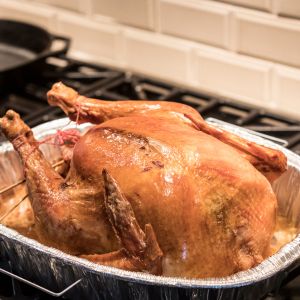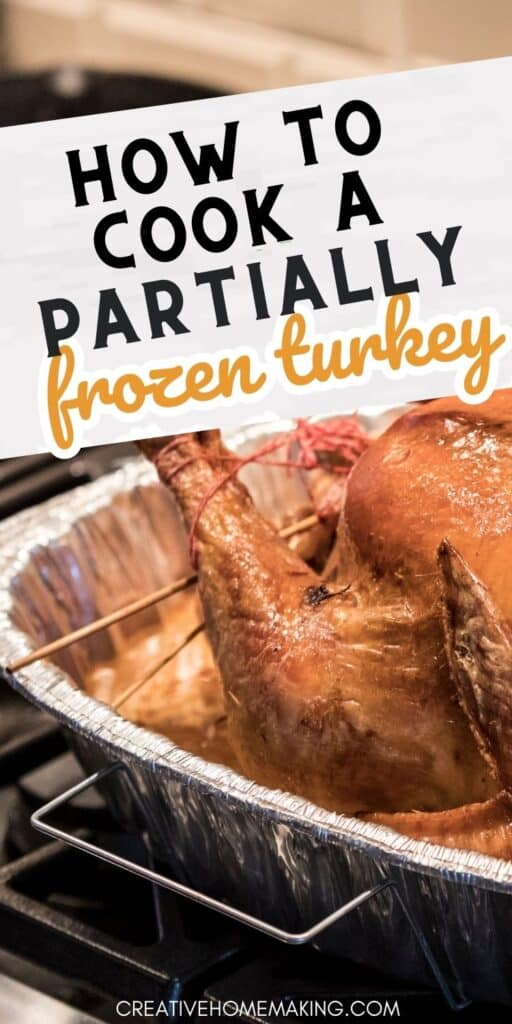When it comes to preparing a turkey for a big holiday feast, timing is crucial. But if you find yourself with a partially frozen turkey on the big day, don’t panic. You can cook a turkey partially frozen, but it’s important to follow the proper steps to ensure safety and even cooking, while also achieving great results.
This post may contain affiliate links.
In this article, we’ll discuss how to safely cook a partially frozen turkey and provide practical tips that will help you achieve a delicious and perfectly cooked bird even in less-than-ideal circumstances. By following these guidelines, you’ll be able to save the day and serve up a memorable feast for your family and friends.
Related Article: How to Cook a Turkey in a Roaster: A Beginner’s Guide
Understanding the Dangers of Cooking Frozen or Partially Frozen Turkey
Bacteria Risks and Food Safety
When you cook a frozen or partially frozen turkey, there are potential dangers you should be aware of, particularly the risk of harmful bacteria like Salmonella and Campylobacter. These bacteria can cause food poisoning, which can be quite uncomfortable or even dangerous, especially for vulnerable populations like children, the elderly, or those with weakened immune systems.
Related Article: Cheeseball Turkey
If a turkey is not cooked to the correct internal temperature, these harmful bacteria may not be destroyed, increasing the risk of foodborne illness to you and your guests. According to the U.S. Department of Agriculture, it’s essential to ensure your turkey reaches an internal temperature of 165°F (74°C) in the thickest parts of the meat.
Danger Zone and Thawing Time
When frozen or partially frozen turkeys are not cooked properly, they may spend too much time in the “danger zone” – the temperature range between 40°F (4°C) and 140°F (60°C) where harmful bacteria can multiply rapidly. This increases the likelihood of food poisoning.
To minimize the risk, it’s essential to know the proper thawing methods and timings for your turkey. Avoid shortcuts like leaving it on the countertop or submerging it in hot water. The CDC recommends thawing the turkey in the refrigerator, allowing about 24 hours of thawing time for every four to five pounds (1.8 to 2.3 kg) of turkey weight.
In situations where your turkey is still partially frozen and you need to cook it, it’s important to adjust your cooking method to ensure it gets cooked to a safe internal temperature. Oven roasting is considered the safest method for cooking a frozen or partially frozen turkey, as grilling, deep-frying, microwaving, or smoking can lead to uneven cooking and an increased risk of food poisoning, as explained by the Mayo Clinic.
Remember, always use a food thermometer when cooking a turkey (frozen, partially frozen, or thawed) to ensure it reaches the safe internal temperature of 165°F (74°C). By being aware of the dangers associated with cooking frozen or partially frozen turkeys and following proper safety guidelines, you can protect yourself and your guests from potential foodborne illnesses.
Related Article: Turkey Pretzel Bites
Thawing a Turkey Properly
When it comes to thawing a turkey, there are a few methods you can use to ensure that it is properly defrosted before cooking. By following any of these methods, you can avoid the risks associated with cooking a partially frozen turkey.
Refrigerator Method
The refrigerator method is the safest way to thaw a turkey. Here’s how to do it:
- Place the turkey in a shallow pan to catch any juices that may leak.
- Store the turkey on the bottom shelf of your refrigerator, away from other foods to prevent cross-contamination.
- Allow approximately 24 hours of thawing time for every four to five pounds of turkey.
- Check the temperature of your refrigerator – it should be at or below 40℉ to ensure safe thawing.
Remember that a thawed turkey can be stored in the refrigerator for up to two days before cooking.
Related Article: Can You Freeze Meatloaf?
Cold Water Bath Method
If you’re short on time, you can thaw your turkey in cold water. Here’s how:
- Place the turkey in a leak-proof plastic bag to prevent cross-contamination and the turkey from absorbing water.
- Submerge the wrapped turkey in cold tap water.
- Change the water every 30 minutes until the turkey is thawed.
- Allow about 30 minutes of thawing time per pound of turkey.
Make sure to cook the turkey immediately after it’s thawed using this method.
Microwave Method
Thawing a turkey in the microwave can be a last-minute option. Follow these steps:
- Consult your microwave’s instruction manual and set it to defrost mode.
- Remove the turkey from its packaging and take out all clips, tags, and packaged giblets.
- Place the turkey on a microwave-safe plate.
- Microwave in intervals, rotating and flipping the turkey in between to ensure even thawing.
Keep in mind that microwave thawing can be uneven, and you’ll need to cook the turkey immediately after thawing.
Related Article: 7 Thanksgiving Drinks for Kids
Methods to Cook a Frozen or Partially Frozen Turkey
Oven Roasting
To cook a partially frozen turkey in the oven, preheat it to 325℉. Remove any packaging and place the turkey on a roasting rack within a roasting pan, making sure to allow space for juices to collect. A partially frozen turkey will take about 25% longer to cook than a fully thawed one . For instance, a frozen 12-pound turkey might take around 4.5 hours at 325℉. Be sure to check the internal temperature with a meat thermometer to ensure thorough cooking.
Deep-Frying
Deep-frying a frozen or partially frozen turkey is not recommended due to safety concerns. The moisture in a frozen turkey can turn into steam and cause hot oil to splatter, potentially leading to burns or fires. To deep-fry a turkey, it’s essential to thaw it completely before submerging it in hot oil. While not applicable to frozen turkeys, deep-frying is a quicker cooking method compared to oven roasting, taking about 3-4 minutes per pound 3.
Grilling
Grilling a partially frozen turkey is possible by following these steps:
- Preheat your grill to 325℉.
- Remove any packaging, and place the turkey breast-side-up on a grill-safe cooking rack.
- If your grill has a temperature gauge, maintain 325℉ throughout the grilling process.
- Use indirect heat to prevent the turkey’s exterior from burning.
- Depending on the size of the turkey, check for doneness after 2.5 hours.
- Verify the internal temperature of the turkey with a meat thermometer, aiming for 165℉ at the thickest part.
Remember that grilling a partially frozen turkey might take 25% longer than a fully thawed one, and always monitor the temperature of your grill.
Smoking.
Smoking a frozen or partially frozen turkey is a low and slow method that infuses the meat with a smoky flavor. First, make sure to thaw the turkey as much as possible. Then, preheat your smoker to 225℉. Place the turkey on a smoking rack, and insert a meat thermometer into the thickest part. Smoke the turkey for approximately 30 minutes per pound. Check the internal temperature regularly, aiming for a minimum of 165℉ for a thoroughly cooked turkey 4.
Be cautious while cooking a frozen or partially frozen turkey. The key to achieving a safe and delicious meal is monitoring the cooking temperatures and adjusting the cooking times accordingly.
Footnotes
Troubleshooting and Frequently Asked Questions
Turkey’s Texture and Taste Issues
If you find yourself faced with a partially frozen turkey, don’t panic. You can still cook it and achieve a delicious and tender bird. However, be aware that cooking a partially frozen turkey may result in some texture and taste differences compared to a completely thawed turkey. To minimize these issues, preheat your oven to 325℉ and place the turkey on a roasting rack in a pan, allowing enough space for the juices to collect (source).
Remember to let the turkey rest after cooking, as it helps retain the moisture and makes for a juicier bird. Tent the turkey with aluminum foil and wait for at least 20 minutes before carving.
Removing the Giblets
It’s important to remove the bag of giblets from the cavity of your turkey before cooking, but a partially frozen turkey may make this task quite difficult. To ease the process, you can follow these steps:
- Fill a large bowl or cooler with cold water.
- Submerge the turkey, focusing on the cavity area.
- Wait for 30 minutes, and then check if the giblets can be removed easily (source).
- If needed, replace the water and repeat the process every 30 minutes until you can remove the giblets.
Remember to always use cold water for thawing, as hot water may increase the risk of harmful bacteria growth on your turkey. With these tips and precautions, you’ll be able to tackle any partially frozen turkey situation and still enjoy a delicious meal with your loved ones.
Follow my Favorite Recipes board on Pinterest.



